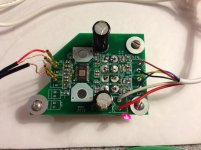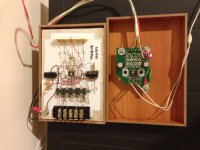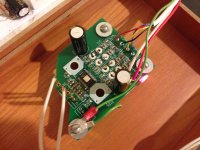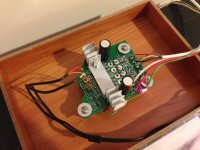I did a quick search on Digikey for "half brick" and immediately got a hit for a low cost heatsink.
A 4.7 deg C/watt (natural cooling), 61 mm x 58 mm x 24 mm (fins) aluminum heatsink with pre-drilled holes is $3.65ea in stock. Very nice! Probably cannot handle more than 10 watts, but perfect size for a class D amp.
VHS-95 CUI Inc | 102-1489-ND | DigiKey
A 4.7 deg C/watt (natural cooling), 61 mm x 58 mm x 24 mm (fins) aluminum heatsink with pre-drilled holes is $3.65ea in stock. Very nice! Probably cannot handle more than 10 watts, but perfect size for a class D amp.
VHS-95 CUI Inc | 102-1489-ND | DigiKey
Told you they were under $5 each in single quantity. Simply unheard of price for almost any other kind of heat sink.
To get a little distance to the heatsink a double adhesive thermal pad could be used. They come in sizes that roughly match the chip (a little oversized but that doesn't matter too much) and in thickness' from 1mm to 5mm with 1 or 2 being the most obvious choices.
Thermal conductivity is over the heatsink's capacity.
http://www.digikey.com/product-detail/en/TG6050-11-11-1/1168-1686-ND/3300344
Also cost next to nothing (under $0.50).
To get a little distance to the heatsink a double adhesive thermal pad could be used. They come in sizes that roughly match the chip (a little oversized but that doesn't matter too much) and in thickness' from 1mm to 5mm with 1 or 2 being the most obvious choices.
Thermal conductivity is over the heatsink's capacity.
http://www.digikey.com/product-detail/en/TG6050-11-11-1/1168-1686-ND/3300344
Also cost next to nothing (under $0.50).
Last edited:
Update on TPA3116D2 build
So I squeezed in some time between waking up and going to work to solder the 3116 onto the PCB this morning. Got it done but was in a rush and of course it did not work when I fired it up for the first time. I hate leaving a nonworking build because of time constraints. Anyhow, had more time after getting home to go over it with a loupe and continuity checker and found a microscopic solder bridge between the bootstrap capacitor and the Vcc rail. Need to rework it with some solder braid. Crossing my fingers....
I hate leaving a nonworking build because of time constraints. Anyhow, had more time after getting home to go over it with a loupe and continuity checker and found a microscopic solder bridge between the bootstrap capacitor and the Vcc rail. Need to rework it with some solder braid. Crossing my fingers....
So I squeezed in some time between waking up and going to work to solder the 3116 onto the PCB this morning. Got it done but was in a rush and of course it did not work when I fired it up for the first time.
TPA3116D2 is a Success!
Yep that solder bridge was the problem. I had to take an xacto knife to break it - solder wick could not remove it. Powered it up and it works like a champ. It sounds great. So far I can't tell the difference between this and the 3118 without taking the volume up. It's night time so the extreme volume would not be very good to try out now. I owe a Big Thanks to Dug for his help and providing the PCB.
It sounds great. So far I can't tell the difference between this and the 3118 without taking the volume up. It's night time so the extreme volume would not be very good to try out now. I owe a Big Thanks to Dug for his help and providing the PCB. 
Yep that solder bridge was the problem. I had to take an xacto knife to break it - solder wick could not remove it. Powered it up and it works like a champ.
Attachments
Last edited:
Half brick is $3.65 but full brick jumps to $21 ea! What's the deal with that? You could buy two halves and be better off.
I think it might because the full brick is an old standard. Think of it similar to a 5.25" hdd. Would be difficult and expensive to find. These days 3.5" and 2.5" are the used standards much as the half and quarter bricks being extremely cheap.
If you really want to get 50 watts/channel into 4 ohm load with the 3116 you will need a real power supply. Laptop 19 volt, 4.65 amp smps bricks are great because they are cheap ($10) and compact but will only provide 90 watts or about 40 watts/ch with inefficiency. To eek out the remaining 10 watts per channel will cost an extra $25 for a real power supply. Is it worth it? Probably not, but if you had to do it, the Meanwell smps at 24 volts and 6.5 amps will provide plenty of power and costs $35 and is about the cheapest ps for this level. S-150-24: MEAN WELL: Power Supplies & Wall Adapters
If you really want to get 50 watts/channel into 4 ohm load with the 3116 you will need a real power supply.
I would not dream of ever reconnecting my system to grid power. It's completely solar powered and runs directly on batteries with a 1F stiffener cap.
For me the 50w/channel would be at 24V into 8 ohm speakers. The 24V would be with 2 batteries in series so effective voltage could reach just below 27V. And 8 ohm impedance would actually be real live speakers that could reach 6.4 ohm at impedance minimum. It would still only be about 45w/channel before audible clipping, so we're still on the safe side here with 10% margin.
Also remember that at 19V 5A laptop brick is probably far more than you actually need. Average level in music is about 9-10dB lower than RMS level as an industry standard. That's why class D amps are so much more effective than class AB amps in the first place. Peak or even RMS efficiency is irrelevant with music, it's the efficiency at 10% of RMS output and lower that is important. And here class AB amps generally falls to 18-22% maximum efficiency while class D amp like the TPA3116D2 remains at 76-82% efficiency.
Btw, the above is one of the reasons I am so interested in the TPA3116D2 in the first place. It's got one of the lowest quiescent currents on the marked at only 20mA (@12V, 32mA@24V) and therefore also one of the very best real life efficiency ratings. And it even has the option to improve low power efficiency by using the 1PSW modulation option that basically transform it into a single ended amp at very low power levels with higher THD, yes, but with much improved sound quality and efficiency.
Last edited:
Saturnus,
The use of two SLA's did cross my head and are actually very reasonably priced. Do you live out away from the grid or is it just a matter of principle not to use the electricity "from the tap"? I did not realize the 3116 has such good efficiency ratings and you are right about real music listening levels and efficiency. I should connect it to some SLA's to see how ling it can run... For camping or powering a stereo at a remote place like a cabin or outpost, the 3116 seems ideal. The SE modulation scheme does get you higher efficiency and the amp has such low THD specs to start with, I don't even think I would notice - although the modulation scheme now involves a zero crossing which will surely change the character of the sound to maybe like a class B amp?
I finally made a proper heatsink now I can push higher powers
The use of two SLA's did cross my head and are actually very reasonably priced. Do you live out away from the grid or is it just a matter of principle not to use the electricity "from the tap"? I did not realize the 3116 has such good efficiency ratings and you are right about real music listening levels and efficiency. I should connect it to some SLA's to see how ling it can run... For camping or powering a stereo at a remote place like a cabin or outpost, the 3116 seems ideal. The SE modulation scheme does get you higher efficiency and the amp has such low THD specs to start with, I don't even think I would notice - although the modulation scheme now involves a zero crossing which will surely change the character of the sound to maybe like a class B amp?
I finally made a proper heatsink now I can push higher powers
Attachments
Last edited:
Thanks for all your help Dug. You led us all down this path by being the first to run it with your own pcb. It really is a simple circuit and your design is fantastic. It sounds wonderful. I shake my head when I listen to it and look at it, I just marvel at the technology that has let TI put the equivalent of a 20 lb rackmount amp from 20 years ago into something the size of credit card.. It is so small and the sound is so big, deep, wide, spacious, open, .... clear. I love this amp! 


Thanks again for the help and the inspiration!
Thanks again for the help and the inspiration!
Yep that solder bridge was the problem. I had to take an xacto knife to break it - solder wick could not remove it. Powered it up and it works like a champ.It sounds great. So far I can't tell the difference between this and the 3118 without taking the volume up. It's night time so the extreme volume would not be very good to try out now. I owe a Big Thanks to Dug for his help and providing the PCB.

Hey, it looks good (a lot better than the foam board one
Regards,
Lo Tse,
It's all worth it. Great sounding amp. What's interesting is that the foam core version is just as quiet and sounds just as good as the PCB. Just not robust. I highly recommend both of these amps, you can't go wrong. As a DIY it is very cost effective.
My 71 year old eyes and thumbs would have difficulty assembling this tiny stuff - SMD's, etc.
I will sure be looking for the availability of an assembled board on these amps.
Cheers,
Rod
My 71 year old eyes and thumbs would have difficulty assembling this tiny stuff - SMD's, etc.
I will sure be looking for the availability of an assembled board on these amps.
Cheers,
Rod
nmboater,
That is my problem too. My right eye's vision is below normal, I can handle through hole components without issue. However, tiny SMD's could likley cause me problem and frustration.
Regards,
nmboater,
That is my problem too. My right eye's vision is below normal, I can handle through hole components without issue. However, tiny SMD's could likley cause me problem and frustration.
Regards,
I don't have very good vision either but the magnifying binocular headband goggles are critical to doing SMD soldering - probably just as important as a good pair of tweezers (Swiss made stainless) and a good soldering iron. Before the goggles the parts looked like fleas or bits of dust and grit. With goggles, you can read the ohm ratings on the resistors and the parts resemble thru hole component sizes. The technique is totally different though. One thing that is different with SMD soldering is that you use a small tray to place your parts that you will immediately solder and you solder them. They don't come from a bin and you don't put them back. You remove each from a tape sealed reel strip one by one. Whatever you open from the reel strips you use. Otherwise you will mix up components and many like caps are not labled. I know it seems daunting but it is not that bad.
xrk971, Now that's a prototype to be proud ofnext step pcb layout & fab
Cheers
Rick
Thanks Rick.
My 71 year old eyes and thumbs would have difficulty assembling this tiny stuff - SMD's, etc.
I will sure be looking for the availability of an assembled board on these amps.
Cheers,
Rod
At work, I use a stereo zoom microscope for SMD work. Cheap used ones can be had for under $100 at you-know-where
TPA3116D2 Listening Impressions (daytime)
With a proper heat sink installed and daytime hours to listen unrestricted by volume levels I put the amp through my usual CD's (Dave Brubeck, Suzanne Vega, Fiona Apple, Sade, Dire Straits, Cowboy Junkies, Blues Travellers, Led Zeppelin, Alicia Keys, Bruce Springsteen, Rebecca Pidgeon) I am running it off an old HP laptop power supply brick with 19 volts and about 65 watt capacity so I am not going to be able to get near the output capacity but that would be too loud to be tolerable.
The first thing that I am noticing is the resolution of micro dynamics that I did not hear before. Small nuances in vocal inflections are coming out. Some tracks that have a lot of jazz drums going on, I am hearing new detail that was missed before - very cool. It is like getting a new better recording of your favorite CD's. I turned volume up loud and the sound is clear and effortless no distortion at all. For CD's that are recorded with a 2 mic setup, the sound stage and spatial imaging is amazing. Overall, the amp is very balanced: it handles the lows, mids, highs all very well and neutrally. This would make sense according to published THD curves, if you stay below 30 watts/ch THD is less than 0.1%. With the heats sink installed there is never any perceptible warmth from the heat sink that can be felt. I would estimate that at levels I was listening to maybe less than 2 watts thru the heat sink. I will need drivers that can handle more than 30 watts to really give it a test at max power. I suppose I can just parallel a subwoofer to it and see how it handles the combined load.
Conclusion: this is the best amplifier I now have and one of the best sounding amplifiers I have heard at any price. Kind of strange to say it is one of the best I have heard but there you have it. I think Texas instruments has a new low power class D champ here. It will just be a matter of time before companies like Topping, Sure, Dayton, 41hz, and the numerous Chinese amp board companies, etc start to make commercially available units to replace the Tripath's that have long held these positions. After building it and seeing the cost of the SMD component BOM for single units, you can also expect that this will be a very reasonably priced nice sounding amp.
I think Texas instruments has a new low power class D champ here. It will just be a matter of time before companies like Topping, Sure, Dayton, 41hz, and the numerous Chinese amp board companies, etc start to make commercially available units to replace the Tripath's that have long held these positions. After building it and seeing the cost of the SMD component BOM for single units, you can also expect that this will be a very reasonably priced nice sounding amp.
With a proper heat sink installed and daytime hours to listen unrestricted by volume levels I put the amp through my usual CD's (Dave Brubeck, Suzanne Vega, Fiona Apple, Sade, Dire Straits, Cowboy Junkies, Blues Travellers, Led Zeppelin, Alicia Keys, Bruce Springsteen, Rebecca Pidgeon) I am running it off an old HP laptop power supply brick with 19 volts and about 65 watt capacity so I am not going to be able to get near the output capacity but that would be too loud to be tolerable.
The first thing that I am noticing is the resolution of micro dynamics that I did not hear before. Small nuances in vocal inflections are coming out. Some tracks that have a lot of jazz drums going on, I am hearing new detail that was missed before - very cool. It is like getting a new better recording of your favorite CD's. I turned volume up loud and the sound is clear and effortless no distortion at all. For CD's that are recorded with a 2 mic setup, the sound stage and spatial imaging is amazing. Overall, the amp is very balanced: it handles the lows, mids, highs all very well and neutrally. This would make sense according to published THD curves, if you stay below 30 watts/ch THD is less than 0.1%. With the heats sink installed there is never any perceptible warmth from the heat sink that can be felt. I would estimate that at levels I was listening to maybe less than 2 watts thru the heat sink. I will need drivers that can handle more than 30 watts to really give it a test at max power. I suppose I can just parallel a subwoofer to it and see how it handles the combined load.
Conclusion: this is the best amplifier I now have and one of the best sounding amplifiers I have heard at any price. Kind of strange to say it is one of the best I have heard but there you have it.
- Home
- Amplifiers
- Class D
- Cheap TPA3118D2 boards, modding them and everything that comes with it



